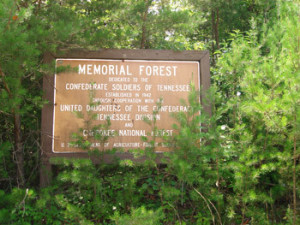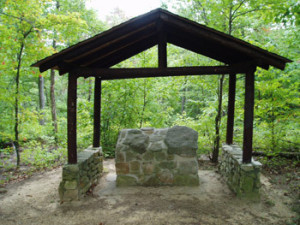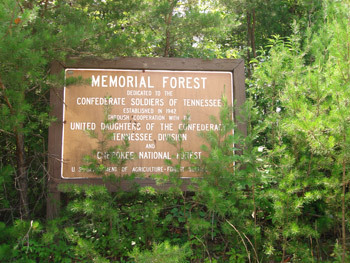In Polk County, nestled in the southern Appalachian Mountains, a site and stories mark the vast extent of violence during the Civil War. Unlike most other eastern Tennessee counties all military units in the Civil War raised in Polk County were Confederate.
 The most well-known event was the 1864 “Polk County Murders” or the “Madden Branch Massacre” – when rebel forces under command of Kentuckian Captain Gatewood attacked and raided numerous local citizens – killing as many as 27 citizens. The killing and raiding extended from the Conasauga River to Benton to Greasy Creek to the Ocoee River.
The most well-known event was the 1864 “Polk County Murders” or the “Madden Branch Massacre” – when rebel forces under command of Kentuckian Captain Gatewood attacked and raided numerous local citizens – killing as many as 27 citizens. The killing and raiding extended from the Conasauga River to Benton to Greasy Creek to the Ocoee River.
(AT RIGHT: Commemorative sign marks the southern edge of the Memorial Forest along US Highway 64 at Boyd’s Gap, east of the Whitewater Center.)
The story as reported in the Official Records reveals that victims and members of the raiding forces were from Bradley and Polk Counties – a story that underscores the deep divide of brothers against brothers during the Civil War. “Bryant Coxey, after having served in the rebel army, got out, has taken the oath, and is protected at home, while his son is killing his neighbors.” (Coxley’s son, from the local area, assisted in the1864 murders and robberies- Tennessee Civil War Sourcebook)
A memorial atop Chilhowee Mountain tells the story of a Feb. 15, 1865 skirmish. Union soldiers, pursuing Confederate bushwhackers, attacked while the Confederates camped atop Chilhowee Mountain. At least one Confederate soldier was killed. Today chiseled stones mark the campsite:
“T.B. Haney
A Confederate Soldier
Was Killed Here
Feb.15, 1865
Soldiers Campsite, Feb. 15, 1865
Capten P.O. Bible
• Lieutenant P.L. Bible
• Lieutenant A.D. Donaldson
Tom Haney killed
W.M. Crockets Leg Shot
Crawled to Grassey Creek
Jasper McConnell
George Renfro captured
Co B 62th Tenn. C.S.A.
The Confederate Memorial Forest
At the onset of World War II, the United Daughters of the Confederacy (UDC) in cooperation with the U.S. Forest Service commemorated the sacrifice of Tennessee Confederate soldiers by creating a living memorial in the Cherokee National Forest. According to local historians, the Civilian Conservation Corps planted the seedlings provided by the UDC. The “Memorial Forest” was a more than 100 acre tract of land dedicated in 1942 to the 115,000 Tennessee “boys in grey.” Trees were planted in an area in need of reclamation – in memory of each “gallant son, and it will also demonstrate that we are working in these war times for flood control, reforestation, to correct soil erosion and the preservation of bird life.” (Minutes, 49th Annual Convention, United Daughters of the Confederacy) US Highway 64, once bisecting the memorial forest, is now located along the south side of the Memorial Forest. While a sign along Highway 64 marks the Memorial Forest, the Southern Pine Beetle has destroyed many of the trees planted in the 1940s.
 Note: Another UDC “Confederate Memorial Forest” was set aside in western North Carolina in 1940 in the Pisgah National Forest. At the same time, other living forest memorials were reportedly either established or contemplated in Kentucky and northeastern Tennessee.
Note: Another UDC “Confederate Memorial Forest” was set aside in western North Carolina in 1940 in the Pisgah National Forest. At the same time, other living forest memorials were reportedly either established or contemplated in Kentucky and northeastern Tennessee.
(AT RIGHT: A shelter atop Chilhowee Mountain protects the hand chiseled stones describing the 1864 skirmish.)

